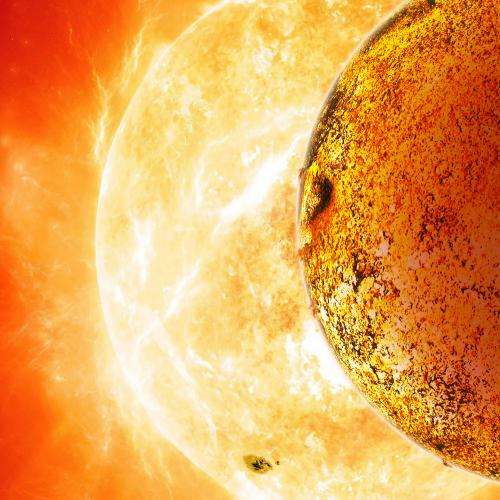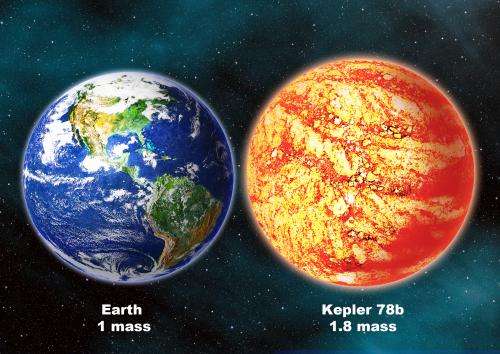Kepler 78b exoplanet is Earth-like in mass and size

In August, MIT researchers identified an exoplanet with an extremely brief orbital period: The team found that Kepler 78b, a small, intensely hot planet 700 light-years from Earth, circles its star in just 8.5 hours—lightning-quick, compared with our own planet's leisurely 365-day orbit. From starlight data gathered by the Kepler Space Telescope, the scientists also determined that the exoplanet is about 1.2 times Earth's size—making Kepler 78b one of the smallest exoplanets ever measured.
Now this same team has found that Kepler 78b shares another characteristic with Earth: its mass. By analyzing the movement of its host star, Kepler 78, the scientists determined that the exoplanet is about 1.7 times as massive as the Earth. From the same measurements, they calculated that the planet's density is 5.3 grams per cubic centimeter, closely resembling Earth's density (5.5 grams per cubic centimeter).
The findings make Kepler 78b the smallest exoplanet for which the mass and size are known. These new measurements provide strong evidence that Kepler 78b is composed mostly of rock and iron, similar to Earth.
However, that's where the similarities may end: The exoplanet, due to its extreme proximity to its star, is likely blazing at temperatures too high to support life.
"It's Earth-like in the sense that it's about the same size and mass, but of course it's extremely unlike the Earth in that it's at least 2,000 degrees hotter," says team member Josh Winn, an associate professor of physics at MIT and a member of the Kavli Institute for Astrophysics and Space Research. "It's a step along the way of studying truly Earth-like planets."
Winn and his colleagues, including lead author Andrew Howard, of the University of Hawaii, publish their results this week in the journal Nature. The group's results appear in the same issue as a paper published by a separate group in Geneva, reporting similar results—scientific agreement that Winn says adds confidence to the mass measurement.
Watching for a wobble
Planets with extremely tight orbits offer scientists a wealth of data: For instance, each week Kepler 78b circles its star about 20 times, giving researchers numerous opportunities to observe its behavior.

The team previously determined Kepler 78b's orbit and size by analyzing the light given off by the star as the planet passes in front of it, or transits. The researchers detected a transit each time the star's light dipped, and measured this dimming to determine the planet's size. (The bigger an exoplanet, the more light it blocks.)
Measuring the planet's mass was a somewhat trickier endeavor. Instead of tracking the planet's motion, the researchers tracked the motion of the star itself. Depending on its mass, a planet can exert a gravitational tug on its star. This stellar motion can be detected as a very slight wobble, known as a Doppler shift.
Winn and his colleagues looked to measure Kepler 78's Doppler shift by analyzing observations from the Keck Observatory in Hawaii—one of the largest telescopes in the world. The team analyzed starlight data taken over a period of eight days. Despite the telescope's strength, the signal from the star was incredibly faint, making a daunting task for the scientists.
"Each of the eight nights along the way, we were agonizing over it, whether it was worth continuing or not," Winn recalls.

Out, damn starspot
In addition to the challenge of picking out such tiny signals, the researchers had to contend with an effect that initially muddled the data: starspots, dark patches on the surface of stars. Graduate student Roberto Sanchis-Ojeda, who has studied the effect of starspots on exoplanet detection, says the troublesome patches can make a star's Doppler shift appear larger, dramatically complicating scientists' calculations of a planet's mass.
Sanchis-Ojeda was able to solve this puzzle by taking into account Kepler 78's rotational period. By tracking the frequency at which certain starspots reappeared, Sanchis-Ojeda determined that the star completes a full rotation every 12.5 days—considerably longer than the planet's orbital period of 8.5 hours. From these measurements, Sanchis-Ojeda was able to calculate the star's true Doppler shift.
From his calculations, Sanchis-Ojeda found that the star rotates relatively slowly, at 1.5 meters per second—about the speed of a jog, or a brisk walk.
"The star is moving at the same speed as when we walk to school or go grocery shopping," Sanchis-Ojeda notes. "The difference is that this star is 700 light-years away, so imagine how complicated it is to measure such speeds from so far away."
From the star's Doppler shift, the team determined that Kepler 78b's mass is 1.7 times that of Earth—a measurement that suggests the planet is made mostly of rock and iron. Such a composition, Winn says, is not surprising, given the planet's extremely close proximity to its star. A less massive planet, such as one made entirely of gas, would not be able to hold together in such a tight orbit.
While its similarities to Earth likely end with Kepler 78b's size and mass, Winn says there is still more to learn about the planet, such as its surface and atmospheric composition—a goal that the group plans to pursue next.
More information: dx.doi.org/10.1038/nature12767 and dx.doi.org/10.1038/nature12768
Journal information: Nature
Provided by Massachusetts Institute of Technology



















